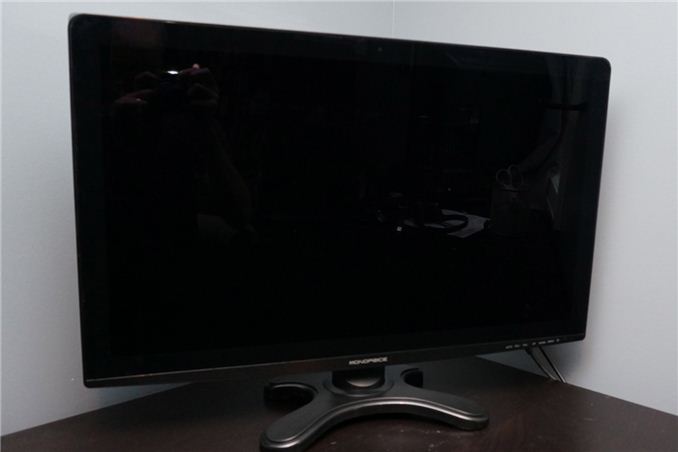Monoprice IPS-Glass Panel Pro 27" LCD Monitor
by Chris Heinonen on October 22, 2013 2:40 AM EST
The first Monoprice display I looked at didn’t fare well. While very affordable, it only offered a DVI input and very little in the way of controls. The worst sin was that the brightness control on the display just didn’t work correctly. A step up from that model is their IPS-Glass. With HDMI, DSub, and DisplayPort inputs to go with a dual-link DVI input, it is far more flexible than the cheaper model. It also returns the display controls to the front of the monitor instead of the rear. As important as these changes are, it won’t really matter if the issues found in the cheaper model exist here.
The Monoprice IPS-Glass Pro Panel is a 27”, 2560x1440 display using an IPS panel. It has a standard white LED backlight and uses the standard sRGB color gamut. To utilize the full resolution you’ll need to use the DVI or DisplayPort inputs as the HDMI port is 1.4a but not capable of the full 2560x1440 resolution. The included stand offers a bit of tilt but no other adjustments are available, though the 100mm VESA mounting holes make it easy to replace that with a better model if you desire. The features of the Monoprice are rounded out by a pair of speakers on the rear of the display.
The menu system inside of the Monoprice is exactly like that of the Nixeus displays. With a lot of these cheaper displays the panels and electronics are all being sourced from the same suppliers. There is still a lot that a company can do to improve upon the default performance, but the guts are the same. Unlike the cheaper Monoprice display we're glad to report that the Brightness control here works properly. Beyond the Brightness and Contrast controls you have a few preset modes that are best avoided, and a single point white balance control. There is a dynamic contrast mode but it blows the gamma curve way out of proportion, crushing shadows and highlights in the process. Overall the controls are bare-bones, but they do operate correctly.
The Monoprice IPS-Glass panel has a substantial feeling to it. There are vents at the top and the bottom and the display stays cool during use. Using an external power brick helps with this but also means another item on/near your desk. The bezel is a thick piece of glossy plastic that really picks up fingerprints, so try to avoid touching it if you can. It helps to slightly enhance the apparent contrast to your eye though I still prefer a matte finish that doesn’t show smudges as easily. The screen surface is very glossy as well. If you are in a room with bright, direct lighting the glare is probably going to be an issue.
The speakers provide adequate sound but are nothing to write home about. If you have no other speakers handy they can suffice, but that's about all I'd say of them. Since they’re rear-mounted they may also get muffled if you wall-mount the display, though wall mounting is usually only something we see with HDTVs so it's probably not a major concern. Overall the Monoprice design shows its value roots but it does not feel cheap. The HDMI resolution limitation would be a bigger deal without DisplayPort but most people should be fine with that.
| Monoprice IPS-Glass Panel Pro | |
| Video Inputs | DVI-DL, DisplayPort, HDMI, Dsub |
| Panel Type | IPS |
| Pixel Pitch | 0.2331mm |
| Colors | 1.07 Billion (A-FRC) |
| Brightness | 440 cd/m^2 |
| Contrast Ratio | 80,000:1 |
| Response Time | 6ms GtG |
| Viewable Size | 27" |
| Resolution | 2560x1440 |
| Viewing Angle (H/V) | 178/178 |
| Backlight | White LED |
| Power Consumption (operation) | < 90W |
| Power Consumption (standby) | < 1 W |
| Screen Treatment | Glossy |
| Height-Adjustable | No |
| Tilt | Yes |
| Pivot | No |
| Swivel | No |
| VESA Wall Mounting | Yes, 100mm x 100mm |
| Dimensions w/ Base (WxHxD) | 25.9" x 19" x 8.5" |
| Weight | 18.3 lbs. |
| Additional Features | 2W Stereo Speakers |
| Limited Warranty | 1 Year |
| Accessories | Power Cord, Power Brick, 3.5mm Audio Cable, DL-DVI Cable |
| Price | $474 |






















41 Comments
View All Comments
az060693 - Tuesday, November 3, 2015 - link
Insanely late comment on an old review, but the part about the HDMI port being unable to support 1440p@60fps is false. It runs fine off my GTX 960 via HDMI; I later switched over to displayport to use the HDMI port for my Xbox, but it ran fine for months on HDMI.Interestingly, because of the above 1080p resolution, Nvidia didn't automatically default to HDTV colorspace settings like it does for 1080p and lower resolution monitors.